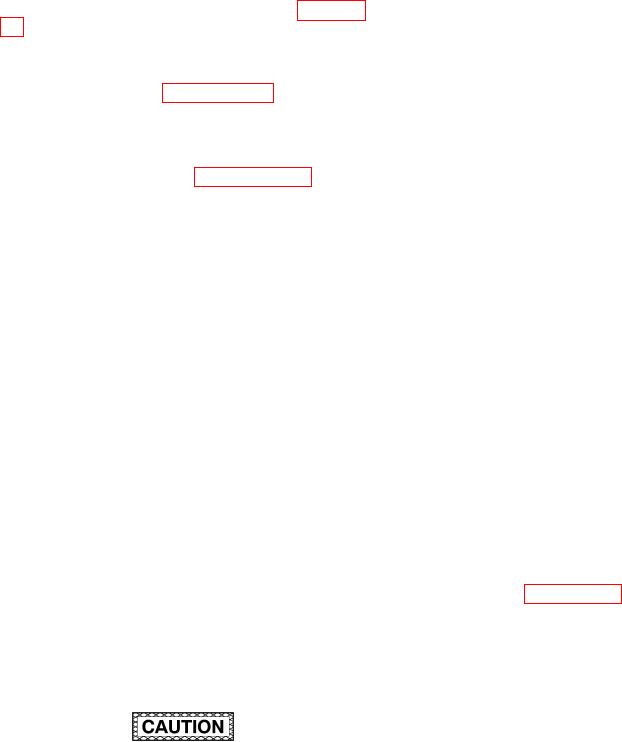
TM 1-1500-204-23-11
d. Edge Trimming. Trim edges using the split helix
drill bit. Use micarta, wood or masonite
as backup material irmly clamped to the
router bit and a template as described in paragraph
drill exit side.
6-4b1 above except use backup material (micarta,
wood or masonite) irmly clamped to the edge being
trimmed. Do not exceed a feed rate of 15 inches
(b) Set up the Align-A-Drill. Adjust the
per minute. Back sand and seal the trimmed edge
hydraulic check damper to obtain a
to remove fuzzing per paragraph 6-10f below.
maximum feed rate of 120 seconds per
inch.
e. Repair Joint Machining. Externally bonded
patches use a blunt cut repair joint. This is formed
(c) Drill Press. A drill press and backup
during the penetration damage removal operation.
material may be used in lieu of the Align-
The method described in paragraph 6-15h makes
A-Drill and drill bushing. Ensure the drill
use of X-acto knives or razor blades to cut through
bit is properly chucked to prevent wob-
individual woven plies of Kevlar. Some care must
ble. Do not operate the drill press at
be used with this technique as a signiicant amount
speeds in excess of 2,000 RPM. Use a
of force is required to cut through the cured epoxy
feed rate of 0.5 inch per minute.
matrix and the Kevlar ibers. There is a tendency to
cut deeper than required. Be careful not to cut any
(2) Countersinking. Following drilling, lami-
deeper than the ply being removed or a reduction in
nate holes must be countersunk if lush head fasteners
joint strength will result. Use only sharp blades and
are to be installed. To ensure countersinks are cut
replace them frequently. Use a straight edge and/or
to the proper depth and are correctly oriented with
templates to assist in cutting.
the part surface, a countersink micro stop cage is
required.
f. Removal of Fuzzing by Back Sanding. Hand
sand fuzzed areas with 120-150 grit silicon carbide
(a) Select the countersink cutter with the
abrasive paper. Sand away from the center of the
pilot diameter that corresponds to the
laminate in one direction only. After majority of fuzz
drilled hole being countersunk. Insert
is removed, dress the edge by lightly sanding parallel
the cutter in the micro stop cage and
to the edge of the laminate. Vacuum clean sandpaper
adjust depth.
frequently to remove Kevlar sanding residue. Fol-
lowing removal of fuzz, coat back sanded areas with
(b) Apply lash breaker tape to outside sur-
epoxy resin and cure to prevent excessive moisture
face of hole to be countersunk. Cut
intrusion.
through tape to expose fastener hole.
If lash breaker tape is not available,
g. Drilling and Countersinking Kevlar-Epoxy
fuzzing of outer surface plies will occur.
Composites. Use the spade bit, dagger bit, and the
Remove fuzzing and reseal with resin
brad point bit or carbide countersink cutters. Bits
per paragraph 6-10f.
and cutters should be inspected after each hole for
Kevlar ibril clogging. Keep bits and cutter clean to
(c) Install the micro stop cage in a 2,000
improve quality of the cut. The brad point drill is a
RPM drill motor. Center cage over hole
special drill bit designed to shear the outer surface
to be countersunk and ensure piloted
Kevlar ibers as it enters the laminate and produce
cutter is aligned with hole.
fuzz free holes.
(d) Cut the countersink to the depth set in
the micro stop cage. Use a feed rate
of 0.5 inches per minute. Ensure coun-
tersink cutter is rotating before contact-
Do not use a normal twist luted drill on aramid
ing laminate/lash breaker tape surface
laminates as unacceptable hole quality and
to prevent splintering.
laminate damage will result.
(3) Cutting. When using scissors to cut aramid
(1) Drilling. A drill bushing, drill guide and
fabric or pre-preg, use ones which have a shearing
backup material are required for drilling. Only sharp
edge on one blade and a serrated or grooved surface
drill bits should be used. Replace at frequent intervals
on the other. These serrations hold the material from
(after 15-20 holes).
slipping. Sharp blades should always be used as
(a) Free Hand Drilling. Drill holes using the
they minimize iber damage. Always clean the scissor
Align-A-Drill, a 2,000 RPM drill motor, a
serrations immediately after use so the uncured resin
bushing and drill guide to stabilize the
doesn t ruin the scissors.
6-23

